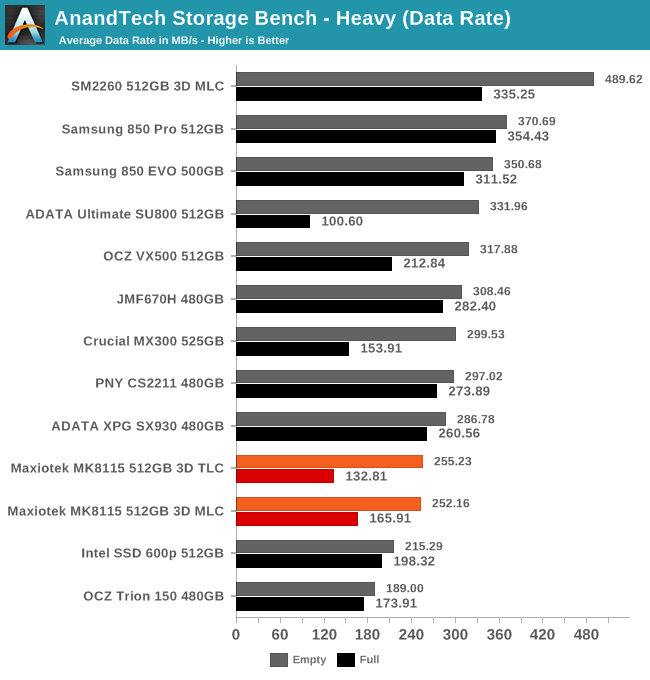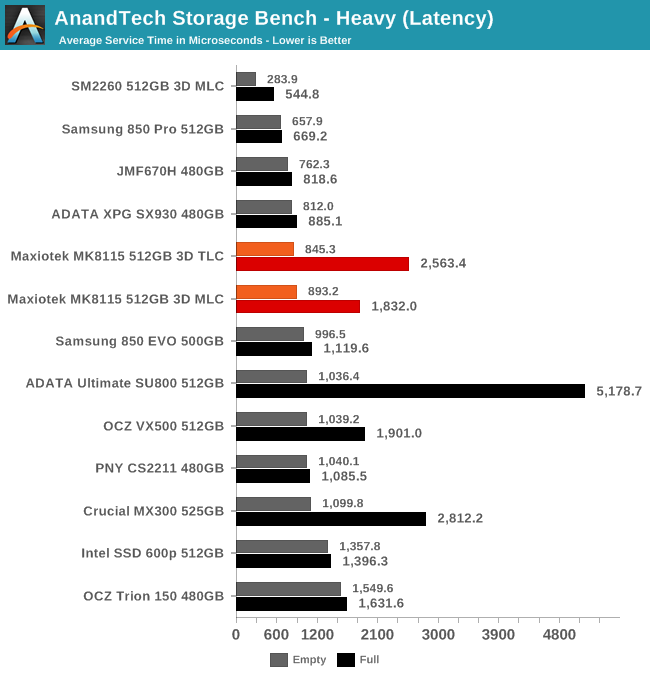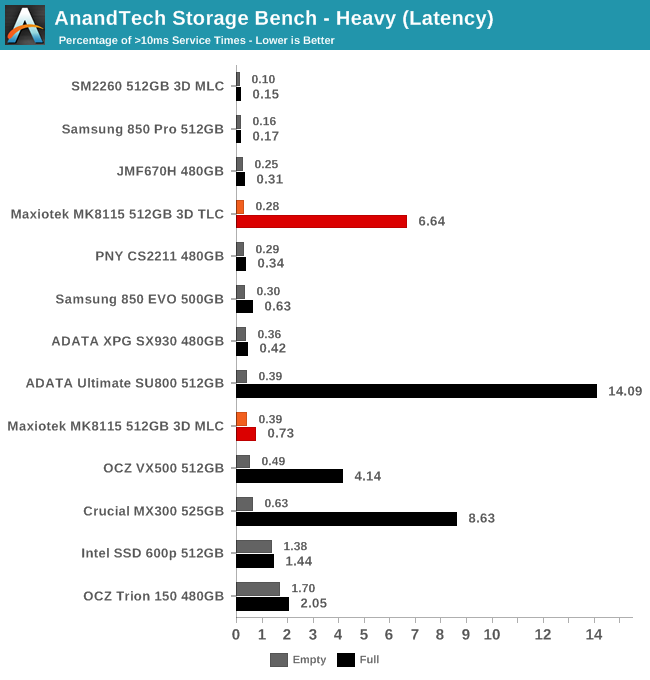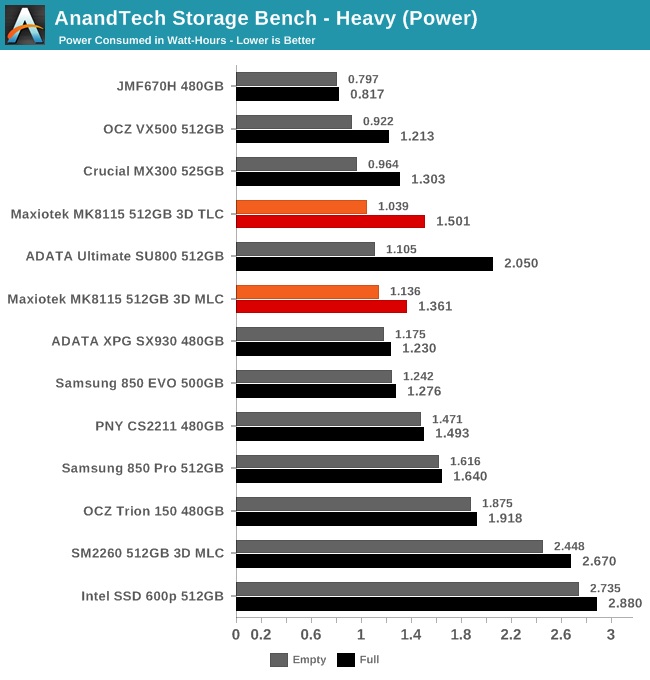Previewing Maxiotek's MK8115 SSD Controller: Can DRAM-less Drives Make The Cut?
by Billy Tallis on May 9, 2017 8:00 AM ESTAnandTech Storage Bench - Heavy
Our Heavy storage benchmark is proportionally more write-heavy than The Destroyer, but much shorter overall. The total writes in the Heavy test aren't enough to fill the drive, so performance never drops down to steady state. This test is far more representative of a power user's day to day usage, and is heavily influenced by the drive's peak performance. The Heavy workload test details can be found here.

The average data rates of the two MK8115 drives on the Heavy test are almost exactly the same when the test is run on an empty drive. Unfortunately that puts both of them quite near the bottom of the charts, behind the older JMicron drives and the other SATA SSDs using Micron 3D NAND.
When the test is run on a full drive, the MK8115 drives' performance suffers greatly, which has also been true of the other two SATA SSDs with Micron 3D NAND that we've tested. Most other SSDs show a far smaller degradation in performance from a full drive.

As on The Destroyer, average service times from the MK8115 drives aren't bad at all, if the test is run on an empty SSD. When the drive starts out full, average service time more than doubles, putting the MLC drive only slightly ahead of the OCZ VX500 and the TLC drive a little ahead of the Crucial MX300.

Both MK8115 drives have good control over high latency outliers when the Heavy test is run on an empty drive. The TLC sample surprisingly scores a bit better than the MLC sample. However, when the test is run on a full drive, the MLC sample's performance degradation is moderate while the TLC drive falls apart, though not quite to the extent of the Crucial MX300 or ADATA SU800.

The energy usage scores of the MK8115 drives on the Heavy test are good. The Crucial MX300 is still a bit better overall, but the Micron 3D NAND drives in general are all fairly efficient. They also all suffer noticeably when the test is run on a full drive, but it's not enough to make them worse than the slowest planar TLC SSDs or the fastest MLC SSDs that prioritize performance over power efficiency.










60 Comments
View All Comments
MajGenRelativity - Tuesday, May 9, 2017 - link
samevladx - Tuesday, May 9, 2017 - link
It will take until Q2 2018 for prices to start going down again.milli - Tuesday, May 9, 2017 - link
You should have included other DRAM-less drives.Billy Tallis - Tuesday, May 9, 2017 - link
I would have, if I had any on hand to test. Nobody's offered one up for review in quite a while, and I've asked a few vendors for a Phison S11 drive but they're not interested.vladx - Tuesday, May 9, 2017 - link
It's pretty obvious why, at least Maxiotek has some guts.bortiz - Tuesday, May 9, 2017 - link
My problem with dram-less ssd is the durability of the drive. How does the life-expectancy of this drive compare to other SSD drives. The DRAM in current SSD drives groups data accesses together, reducing the data array access. This increases performance and array durability. Array durability is proportional to the number of array accesses. I don't think this is a good idea and I would like to see if someone can prove to me that this will have a decent life span (5 years???)vladx - Tuesday, May 9, 2017 - link
Whether a SSD IS DRAM-less or not doesn't influence life expectancy.Billy Tallis - Tuesday, May 9, 2017 - link
SSDs that have external DRAM usually don't use it as a write cache for user data; it's just for caching the mapping metadata. A DRAMless controller like MK8115 can do pretty much the same amount of write combining and wear leveling that a mainstream controller can. There may be a slight increase in write amplification from the controller having to flush metadata updates to the flash more often, but mainstream drives don't want to buffer those writes too much either, for the same safety reasons they don't put user data in the DRAM.Remember that write operations are the only ones that significantly affect drive lifetime. DRAMless controllers need to do more flash reads, but read disturb errors are still too rare for that to matter to drive reliability.
CrazyElf - Tuesday, May 9, 2017 - link
It is difficult for it to make the cut with a low 4k random read and write test like this SSD has.I think that the DRAM cache is well worth it.
I think it is best to hold off on SSDs for now.
rocky12345 - Tuesday, May 9, 2017 - link
Yea no thanks if this is what DRAM-less drives are like I think I will stick to SSD's that can maintain their performance a lot better. I don't care if these drives are a bit cheaper if you end up swearing at your computer because the SSD is lagging then for peace of mind just spend the extra cash on a real SSD.I just sold a gaming system to a customer that had a SSD installed as the windows drive. Yep it booted fast and was pretty peppy but if you tried to work the system it seemed like the SSD would bog right down to a crawl so I would assume it was a DRAM-Less SSD. When I sold the customer on the system I was going off of my own SSD usage on my gaming laptop & gaming desktop options which would never bog down like that. I guess the good news was the customer did come back a few days later and said the system was great and so fast that he never had to wait for stuff to load like he did before on his older setup so he was a happy camper I guess.